Stock Market , Gold, Commodities and Economic Forecasts for 2010
Stock-Markets / Forecasts & Technical Analysis Dec 07, 2009 - 08:33 AM GMTBy: Martin_D_Weiss
 Martin Weiss: Two recent mega-events — the Wall Street collapse in 2008 and the Washington response in 2009 … the debt implosion and then the money printing explosion — are mind-boggling in their dimensions.
Martin Weiss: Two recent mega-events — the Wall Street collapse in 2008 and the Washington response in 2009 … the debt implosion and then the money printing explosion — are mind-boggling in their dimensions.
Neither you nor I can know with certainty what the future will bring. But at this particular juncture, we don’t have to poke around in hidden crevices of the economy. Nor must we stretch our imagination to conjure this or that scenario. To get a pretty good idea of what’s likely to happen next year, all we have to do is follow the path of natural consequences from these two mega-events. And that’s what we’re going to do right here and now.
I have assembled our Weiss Research team of analysts to lay out for you, step-by-step, what those consequences are likely to be in the coming year — 11 startling forecasts for 2010.
Mike Larson is one of the only analysts in the country who accurately predicted both the real estate bust in 2005 and the recent real estate bottom in 2009. Today, he is not only our resident expert on real estate, but also our chief Fed watcher, interest rate specialist and analyst of the entire financial sector.
Larry Edelson, joining us from Bangkok, Thailand, was among the very first to predict that gold would one day exceed $1,000 per ounce, and now that day has come. But Larry’s gold forecast is just one of many that illustrate a special skill he brings to as a Director of the Foundation for the Study of Cycles: Timing the markets.
Claus Vogt, joining us today from Berlin, is the man I’ve personally selected to make the picks — and give the signals — for one million dollars of my own money, based not only on his own years of trading experience but also on the input from our entire Weiss Research team.
I can think of no better person to help us forecast the direction of the global economy and global stock markets.
I hasten to add that forecasting what we believe is likely to happen in 2010 is strictly the first part of our program today. During the second, equally important, part we will give you actionable guidance — investment ideas you can USE to take advantage of the profit and income opportunities that flow directly from our forecasts. And to bring you the best of the best ideas we can, I have also assembled a panel of our investment specialists in each major arena.
Ron Rowland, our specialist on ETFs … Nilus Mattive, our specialist on dividend stocks … and Bryan Rich, our foreign currency expert.
From Southeast Asia, we have our Asia stock specialist Tony Sagami, who just completed a reconnaissance tour of Indonesia and … from Southern South America; we have Sean Brodrick, reporting on his visits to resource companies in Chile and Argentina.
Plus I have invited a special guest, Monty Agarwal, one of the nation’s leading experts on hedge funds, sovereign wealth funds, and global money flows.
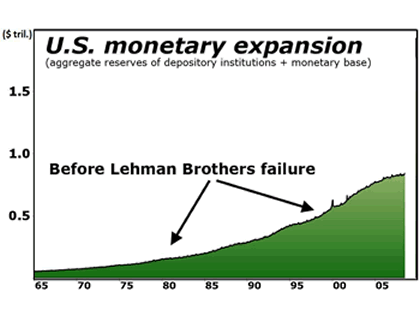 |
Thanks to their participation in this special summit, you benefit from some of the most timely, in-depth and fascinating research in the world today.
Mike Larson: I happen to think the research effort has paid off very nicely. For example, look at the absolutely huge companies that failed, were bought out or bailed out last year! And look how many of those companies Weiss Research specifically named as candidates for failure well ahead of time:
Two of the nation’s largest brokers, Bear Sterns and Lehman Brothers … the nation’s largest mortgage lenders, Countrywide Financial and Fannie Mae … the nation’s largest savings and loan, Washington Mutual … and the nation’s second largest commercial banks, Citigroup.
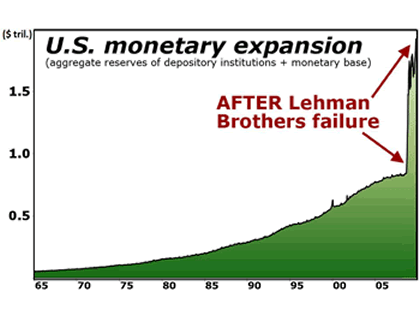 |
And next, look at the utterly massive government reaction to those failures that we have uncovered: Fed Chairman Bernanke has responded with the most rapid acceleration of monetary expansion in U.S. history.
Before the Lehman Brothers collapse last year — it took nearly 14 years for the Federal Reserve to double the cash and reserves at the nation’s banks.
But after the Lehman Brothers collapse, it took Mr. Bernanke’s Fed only 112 days — barely four months — to double the monetary base. In other words, he accelerated the pace of bank reserve expansion by a factor of forty-five to one.
Meanwhile, Treasury Secretary Geithner and his predecessor responded with the largest bailouts of all time, helping to triple the size of an already-bulging federal deficit.
Claus Vogt: Combined, the monetary and fiscal stimulus engineered by the Fed and the Treasury Department represents an estimated 30 percent of the nation’s gross domestic product. That’s three times more than during the Great Depression. And that’s ten times more than that in the average postwar recession.
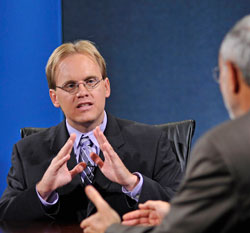 |
Martin: It sounds like science fiction.
Mike: I wish it were. But it’s real.
Martin: Give use your first forecast for 2010.
Mike:
Forecast #1 The Federal Reserve will not relent in its money printing madness until it’s absolutely forced to do so.
Martin: Because …
Mike: Because it’s in black and white — right in the Fed’s own statements, month after month. It’s what they told us they’d do. It’s what they’re doing. And it’s what they’re telling us they’re going to continue doing. We also know Bernanke will pursue this policy because of the persistence of those forces. We’ve had 120 bank failures from the beginning of 2009 through mid November, the most since the S&L crisis of the 1980s.
Martin: An obvious excuse for the Fed to continue printing money! So the pivotal question for 2010 is this: When and how will Mr. Bernanke shift gears? But first, let’s focus on the immediate consequences of the Fed’s money printing.
Larry Edelson: Just connect the dots! They take you straight to
Forecast #2 A continuing, virtually unstoppable long-term decline in the dollar.
 |
Yes, we will have dollar rallies. And yes, the dollar rallies will be sharp. But they will be traps. After each rally, the dollar will consistently resume its long-term decline. Mr. Bernanke is creating massive new supplies of U.S. dollars, ad infinitum. So he’s naturally diluting their value.
Martin: But so far, the U.S. dollar’s decline has been orderly.
Larry: I wouldn’t use the word orderly. Instead, I’d use the words “messy” and “volatile,” and that’s only going to get worse in 2010. 2010 will also bring louder voices demanding that the dollar be replaced as the world’s dominant reserve currency. Most important, at some point, the pressures on the dollar could reach critical mass, and the pace of decline will accelerate. Instead of a zigzag decline, you’ll see a freefall, and ultimately, outright panic.
Claus: A tipping point could come when the dollar makes new, all-time lows …
Martin: … and those lows are already very close.
Larry: Yes. Against the euro, the dollar is just 4 euro cents from its lowest level in the euro’s history. When that low is broken decisively, it could set off a dramatic wave of panicky dollar selling here and in the Euro zone. Against the Japanese yen, the dollar is now just 2.5 yen from its lowest level of all time. When that low is broken decisively, it could set off an even more dramatic wave of panicky dollar selling in Japan. And globally!
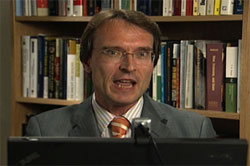 |
Claus: Of course. Investors hold dollars all over the world — not only in the Euro zone and Japan, but also in Southeast Asia, South Asia, the Middle East, and the Americas. Those investors are not only central banks that may still have some political motives to refrain from selling … but also private corporations and individuals who don’t give a darn about politics, who won’t hesitate for a moment to dump their dollars if they feel that’s what it takes to avoid a beating.
Martin: Right. But won’t that kill European export industries?
Claus: Yes, and periodically here in Europe, we will gripe and make noise about how unfair that is. But we cannot complain too loudly. Remember, we also benefit from all this free money. We also have very shaky financial systems. We also have been rescuing our banks and letting our budgets go to hell in a handbasket. Meanwhile, I don’t think the Japanese can complain very much, either.
Martin: Because they have been doing pretty much the same thing as the Fed is doing now … and they’ve been at it for over TWENTY years.
Claus: Yes!
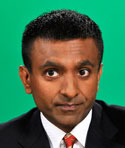 |
Monty Agarwal: Gentlemen, I know I’m new here and you wanted to save me for later, but there’s another factor — a factor so pertinent to this discussion … do you mind if I interject it here?
Martin: I don’t mind at all.
Monty: It’s the sovereign wealth funds, the giant national pension funds, which I track avidly. Not only have they grown dramatically in size — to as much as 3 trillion dollars — but with the dollar decline, they are now becoming far more aggressive in shifting out of the dollar and moving into alternatives — other currencies, other sectors, other continents, such as Asia. Most economists are greatly underestimating their impact. And most investors will probably miss the opportunity to follow their lead to some very profitable asset reallocations in 2010.
Martin: What happens next, gentlemen?
Larry: Let me answer that. Let me tell you what I already see happening among many investors here in Asia … and what could soon become a sweeping, worldwide phenomenon all over the world in 2010.
Forecast #3 The entire concept of “RISK” will be REDEFINED by global investors. The new definition will be: HOLDING U.S. dollars and dollar-denominated assets.
First of all, more and more investors perceive U.S. dollars — and anything denominated in dollars — as high-risk investments. They don’t really care how conservative the instrument is or how strong the company may be. All they see is that it’s wrapped in greenbacks, and they paint everything associated with those greenbacks with a single broad brush and a single color — red for risk.
Martin: Which makes them anxious to dump dollars.
Larry: Yes, but it runs deeper than just currency trading. It means they are compelled to find other assets that can replace the U.S. dollar as stores of value. They must rush to buy alternative forms of money for their wealth …
Martin: Like gold …
Larry: Not just gold, but also silver, copper and other commodities. Not just commodities but also other tangible assets like real estate. Not just tangible assets, but also paper assets that provide a stake in those tangibles … including common stocks!
I call this “the monetization of assets” — the phenomenon whereby other assets of many shades and colors become substitutes for the traditional role money plays as a store of value. That’s the inevitable result of the Fed’s efforts to flood the economy with devalued money.
Claus: And that’s why they’re buying gold.
Martin: Which leads me to this question we often get from our readers: Won’t central banks prevent — or at least moderate — the rise in gold by simply unloading some of their gold hoards on the marketplace?
Larry: No. they’re going to do precisely the opposite, which takes us to our next forecast:
Forecast #4 Gold will reach $1,500 if not higher as central banks help drive up its price with massive new buying of their own.
Martin: When do you see this beginning in a big way?
Larry: It already is! China is actively buying gold, boosting its gold reserves from 600 metric tons to 1,054 metric tons — a 76 percent increase since 2002. India has just spent a whopping $6.7 billion to scoop up 200 tons of gold from the International Monetary Fund.
Martin: But how big is this in the context of the broader global market for gold?
Larry: Are you kidding? It’s equal to roughly 8 percent of all the gold mined in the entire world each year. Meanwhile, in addition to central banks, you’ve got a rush of private investors buying gold. Demand for gold investment products like ETFs soared to a record 1,732 metric tons of gold in the third quarter, $55 billion of gold. All this buying is converging right now. And this is the most obvious factor that will drive up gold in 2010.
Martin: Now, 27 percent of our readers said gold could rocket to somewhere between $1,500 and $2,000. And nearly 8 percent said $2,000 or higher.
Larry: Well, they’re right on, in my opinion! But it won’t be a one-way street. Before going that high, an ounce of gold could dip below $1,000. If it does, it will be a huge buying opportunity, a true gift for gold investors. I’ve said this many times before and I’ll say it again: Every ounce of gold bullion you can buy for less than $1,000 an ounce should be seen as a great bargain.
Martin: Claus, what about oil?
Claus:
Forecast #5 The overwhelming majority of oil producing nations will demand that the U.S. dollar be replaced as the pricing standard for crude oil.
Martin: In past OPEC meetings, the debate was always about how to lower or raise the price of oil.
Claus: That will not be the big issue in 2010. More than ever before, oil will be driven by free market forces, and more than ever, the rise in oil prices will be tied to the fall in the U.S. dollar. As the dollar falls, the demands to replace the dollar will get louder and more unanimous. And as those demands grow in strength, you’ll see more and more upward pressure on oil prices.
Martin: Gentlemen, please be more specific about what that will do to the price.
Larry: Here’s my forecast, based on my work with the Foundation for the Study of Cycles: In 2010, the price of oil will move into a new, higher, and broader trading range — $110 on the high end, $70 on the low end.
Martin: So you don’t see oil making new highs in 2010. Why not?
Claus: Because of the weak demand for energy from the largest economy in the world, the United States. Yes, the U.S. economy is recovering. And yes, the recovery could last well into 2010. But here’s our forecast:
Forecast #6 The U.S. economic recovery of 2010 will go down in history as one of the weakest and shortest in 100 years.
Mike: Never forget: There are currently 27.4 million unemployed or underemployed workers in the United States.
Never forget: Banks are clamping down on credit cards, tightening standards for the last nine quarters in a row, according to the Fed’s own surveys. Also never forget that more than one in five U.S. homeowners has lost all their equity in their home and is upside down on their mortgage.
Plus, now you throw rising gasoline prices and surging heating oil prices into the mix and you’re left with a perfect storm for a very large proportion of American consumers: No job security. No credit. No home equity to tap. And to add insult to injury, rising energy bills.
Claus: In contrast, when you look overseas, you see an entirely different picture:
Forecast #7 The economies of Brazil, China and India will grow up to four times faster than the U.S.
For the most part, their consumers are not threatened by record unemployment, are not overly reliant on credit cards or home equity as a source of spending power … and are not directly impacted by rising energy.
In the U.S., even if the recovery holds until the latter part of 2010, I don’t think you’ll see growth of more than a couple of percentage points. Meanwhile, Brazil will grow by nearly 5 percent, India by 7 percent and China by almost 9 percent.
Martin: Based …
Claus: Based on official government sources, which, in at least two of those countries, have often understated the actual growth.
Martin: Tony, can you help us there? By the way, I understand you’ve now moved back to Asia permanently?
 |
Tony Sagami: I was born in Japan, and moved to the U.S. as a child, and now I’m back living in Asia as an American citizen … and loving every minute of it … although I sure miss the U.S. But to answer your question about the global stock markets, I have all the information here at my fingertips, which brings me to …
Forecast #8 Stocks in countries like China, India and Brazil will rise up to three, four, even FIVE times faster than the S&P 500.
The immediate reason is quite simple — China’s $586 stimulus plan is working like a charm. China didn’t have to borrow a dime to finance that stimulus. And unlike the U.S., which used trillions to buy out worthless sub-prime debt, China spent its stimulus money on highways, airports, dams, utilities, bridges, shipping ports and more. Not only has this created millions of jobs, it has created a foundation of productive infrastructure that will keep the Chinese economy humming for years to come.
Larry: Look. This is not just about one year or even one decade. We are in the first years of one of the most powerful mega-cycles in the history of civilization.
Martin: I know exactly what you’re talking about — the work you’ve done over the years with the Foundation for the Study of Cycles, which you presented to us in an earlier event this year.
Larry: For those who may have missed it or who need to refresh their memory, could you run some key highlights of our session with the Foundation’s Director of Research, Richard Mogey?
Highlights of Our Event with Richard Mogey, Director of Research for the Foundation for the Study of Cycles.
The time is the 1930s, and we’re back in the Great Depression. President Herbert Hoover could not have dreamed of a more adverse environment to begin planning his re-election campaign — not even in his worst nightmares.
The public and the press demand to know who or what was to blame for this catastrophe. To survive, the Hoover Administration would have to give them answers.
But the president knows that just any answer will not suffice. Only a credible, exhaustively documented, scientific answer could have a chance of restoring the public’s faith in his administration and in the U.S. economy.
And so, Hoover turns to a scientist he trusts — a Chief Economic Analyst in the Hoover Administration … named Edward R. Dewey.
Later Dewey will create a nonprofit foundation. And with this foundation he and his successors will continue a 78-year quest for the mysterious forces that drive the economy and investment markets, joined by many of the best minds from Harvard, Yale, Princeton, Oxford, Temple University, Western Reserve and other globally respected institutions.
The mission of the foundation is championed by men at the very pinnacle of the scientific establishment — Charles Greeley Abbott, the Head of the Smithsonian …William Cameron Forbes, the Chairman of the Carnegie Institution … Wesley Claire Mitchell, Founder and Director of the National Bureau of Economic Research…
A former Vice President of the United States — General Charles G. Dawes — joins Dewey’s Foundation. So does Senator Everett M. Dirksen.
Richard Mogey: Dewey discovered a very simple reality — that in modern, industrialized nations, economic expansions and contractions occurred in regular, PREDICTABLE patterns.
Larry: In regular waves — CYCLES!
Richard: Exactly!
Larry: I’ve put together a short list of some of the most outstanding calls in major markets.
Richard: Forecasts of key turning points.
Larry: Yes, the foundation alerted investors to
- the June 1973 high in soybeans …
- the January 1980 high in silver …
- the March 1981 high in crude oil …
- the September 1981 high in interest rates …
- the August 1982 low in the stock market, and …
- the great Crash of 1987 in the stock market.
Richard: These were all very major turns in the history of markets.
Larry: The Foundation forecast …
- the massive bull market in stocks, 1995-2000 …
- the bottom in oil, February 1999 …
- the historic low in commodities, June 2001 …
- the all-time high in stocks, September 2007, and …
- the March 2009 low in the stocks
Congratulations, Richard. This is why Weiss Research has entered into an exclusive, strategic alliance with the Foundation to help give our readers direct access to this valuable timing information.
Richard: Thank you! We also have a much longer, 500-year geopolitical cycle — a major power shift from East to West or from West to East, which is the case now.
Now, we return to our “11 Startling Forecasts for 2010″ …
Martin: That was fascinating, Larry. Congratulations again on introducing us to the Foundation. What I find most remarkable about all of this is not just how accurate the Foundation has been in timing the market, but also how broad their vision is of the future — particularly the 500-year cycle of the massive power shift from West to East.
Larry: We are just in the very early stages of that shift. And clearly, it’s not just about a shift of power. It’s also a shift of capital, wealth and investment opportunities. It’s a wealth shift from economies that are bogged down in debts, deficits — and denial of the dire disasters all around them — to economies that are rich in cash, rich in commodities … and full of confidence in their future. This is probably the most important, the longest term and the sustainable megatrend of our time.
Martin: What does that mean for global stock markets in 2010?
Claus: Here’s our forecast:
Forecast #8 Stocks in countries like China, India and Brazil will rise up to three, four, even FIVE times faster than the S&P 500.
The S&P 500 could rise 20 percent further in the first half of 2010. But as investors begin to realize how weak the U.S. recovery truly is, it’s likely to give up AT LEAST half of those gains in the second half.
So by December, if the S&P is still up 10 percent for the year, it will be a minor miracle. In contrast, don’t be surprised if major foreign markets are up by 30 percent, 40 percent or even 50 percent for the year … three, four or even five times more than the S&P 500.
Martin: Mike, you told me before this conference that you had some strong numbers that illustrate how this has happened in the recent past.
Mike: It’s actually quite consistent. When stock markets are rising, most foreign markets outperform by HUGE margins. So far this year, for example, the S&P 500 has risen by 21 percent. China’s Shanghai Stock Exchange Composite Index is up 75 percent, beating the S&P by factor of 3.6 to one. India’s BSE Sensex index is up 79 percent, beating the S&P by a factor of 3.8 to one. And Brazil’s Bovespa Index is up 139 percent, over SIX times better than the S&P.
In 2007 overall, the foreign markets did equally well — India up 65 percent, Brazil up 72 percent, and China up 110 percent. But since the S&P rose only 3.5 percent, the relative outperformance is far greater: India, almost 19 times better. Brazil almost 21 times better. China thirty-one times better!
So clearly, a forecast of three, four or five times outperformance in 2010 is not at all unreasonable, given the historic precedents.
Martin: Just remember that this is a double-edged sword. Volatility to the upside comes with volatility to the downside. Would anyone venture a guess as to which will do the best of all?
Tony:
Forecast #9 The best performing stock markets in 2010 will include Indonesia, Thailand and Vietnam.
I just completed a five-day fieldtrip to Indonesia, and I was blown away by what I found. Indonesia has the fourth largest population in the world and is growing like a weed. It just reported that its economy grew by 4.2 percent in the third quarter and that’s on top of 4 percent in Q2. That makes it the THIRD fastest growing economy in all of Asia, just behind India and China.
Indonesia is extremely rich in natural resources, especially oil and coal. How rich? Many people don’t realize that Indonesia was the only Asian member of OPEC until it voluntarily withdrew last year. You know why they withdrew? Because their economy was growing so fast and they were making such good use of their own oil, they didn’t need to export it any more. OPEC stands for Organization of Petroleum exporting countries. So if they’re not exporting, why be a member?
Martin:You’ve recently been to Taiwan, Hong Kong, Macao, mainland China, Japan, India … now Indonesia. Where are you going next?
Tony: My next trip is to Xian, China. There are over 100 Universities there and they produce the most engineers of any city in China. That gives them a wealth of talent in technology and engineering, and I am going to visit two companies in particular that tap this talent.
From there, I’m going to Hanoi and Ho Chi Min City. Vietnam is taking aggressive steps to open up its economy. It has recently been privatizing companies and property rights. It’s taking some very broad measures to boost the liquidity of its stock market. Its market is another prime candidate for #1 outperformer next year.
Larry: And Thailand, despite its political problems, is one of the most undervalued markets in Asia, with many stocks trading at less than their book values! Plus, there’s a vast amount of new Chinese money going into Thailand, buying property, buying banks, buying every major asset they can lay their hands on. Which leads us to sovereign wealth funds.
Monty: As you know, major sovereign wealth funds are essentially the national pension funds of some of the world’s richest nations, and my forecast is quite simple:
Forecast #10 Sovereign wealth funds of Asia will become far more aggressive buyers of contra-dollar assets in 2010, helping to drive up their values at a much faster clip than generally expected, especially in Asia.
Just the top ten Sovereign Wealth Funds in the world have nearly $3 trillion in capital. More than 80 percent of that capital originates from the Middle East and Asia — and more than 70 percent of that capital is going into natural resources, which are contra-dollar assets.
Larry: What most people don’t realize is that the sovereign wealth funds are also global trendsetters. When they start gobbling up natural resources, other companies will follow their lead and do the same.
Sean Brodrick: Which leads us to our next forecast:
Forecast #11 Expect a MASSIVE new global boom in mergers and acquisitions, focusing on small- and mid-cap natural resource stocks.
 |
We just saw Goldcorp gobble up a company with gold mining operations in Mexico by the name of Canplats for $238 million. And this acquisition was driven by a wave that will lift a lot more small boats, targeting not only gold, but other natural resource like oil, silver, copper and more. The wave I’m talking about is that the large producers can’t replace their production fast enough.
And it’s accelerating. Bear Creek Mining bought three gold and silver exploration companies in South Peru. El Dorado Gold bought Sino Gold in China. Jin Shan, based in Canada, recently merged into a larger Chinese miner.
Tony: I have another one:
Bonus Forecast 2010 will bring a NEW phase in Asia’s real estate boom — a boom which is both broader and far more sustainable than America’s real estate boom of the 2000s.
Martin: Where in particular?
Larry: I travel throughout Asia. I bought a property here in Bangkok just SIX months ago, and it’s already up 35 percent. So I can answer that question based on first hand information. Real estate prices will naturally be highest in major urban centers where population density is the greatest and real estate is in the tightest supply: Hong Kong, Singapore, Shanghai.
Martin: Gentlemen, this is fascinating. But most investors can’t travel all over Asia like you do. And even if they could, how are they going to buy Asian real estate?
Tony: Are we ready to start naming specific investments?
Martin: Yes!
Tony: In the past, it would have been almost impossible for the average American investor to profit from a real estate boom in Asia. Today, it’s just a matter of buying the right exchange-traded funds — simple ETFs. ETFs are traded on U.S. exchanges. You can buy ETFs with deep discount commissions, or even zero commissions. And you can do it in any standard brokerage account or IRA.
Martin: What about ETFs for Asian real estate?
Tony: You can use IFAS. This ETF owns shares in some of the biggest commercial property developers throughout Asia, including China, Singapore, and Japan.
I have personally visited real estate developments in Shanghai, Beijing and all over China, and that’s where I think you’re going to get the biggest bang for your buck. I’d love to take readers on a tour with me to see some of them — and the HUGE demand for them — first hand. But I don’t have to.
You can buy a stake in China’s real estate with the Claymore/AlphaShares China Real Estate ETF (symbol TAO). This ETF owns companies like Wharf Holdings Ltd. and New World Development, which develop malls, office buildings, and other commercial projects in China.
The main point I’d like to make is that there are ETFs for each and every one of your forecasts, and for nearly all of them, the market liquidity is excellent.
Martin: Forecast #2 was a continuing, virtually unstoppable long-term decline in the dollar. What’s the simplest vehicle for profiting from that trend?
 |
Bryan Rich: Currency ETFs. ETFs that never buy a share of stock, never buy a single bond. ETFs that invest strictly in foreign currencies themselves. These ETFs allow you to profit from the appreciation in the currencies against the dollar. Plus, in several cases, you get the benefit of a higher yield.
For example, the Australian dollar ETF now gives you a full three percentage points more than U.S. Treasury bills or U.S. money markets. The Brazilian real ETF pays you over EIGHT percentage points more!
Martin: The next actionable forecast was gold heading for $1,500. What instruments to do you recommend?
Larry: If you don’t own any gold, decide how much you want to allocate to gold and buy half now, half on a pullback. But don’t put most of that allocation in bullion coins or bars. You’ll have to pay a hefty premium. You’ll have the costs and hassles of storage. It’s simply not for most of your money.
Instead, I use the SPDR Gold Trust ETF (GLD). It’s far more flexible and practical.
In addition, every investor should hold shares in gold miners like Newmont, symbol NEM, and Barrick, symbol ABX; plus some juniors, like Agnico Eagle, symbol AEM; IAMGOLD, symbol IAG; and another up-and-coming company, Jaguar Mining, symbol JAG.
Martin: Forecast #5 was a higher trading range for oil, up to $110 per barrel but NOT new all-time highs. To me, that implies a strategy that also has a strong income or dividend component.
 |
Nilus Mattive: I like Master Limited Partnerships like Kinder Morgan Energy Partners (symbol KMP) and Energy Transfer Partners (symbol ETP), which have dividend yields of 7.6 percent and 8.1 percent respectively. Or, if you want to get broad diversification in MLPs with one shot, you can use the MLP & Strategic Equity Fund (MTP), which pays an annual yield of 5.7 percent.
Martin: The next actionable forecast was on the strong potential outperformance of stocks in countries like China, India and Brazil. What are the best vehicles?
Tony: There’s a solid ETF for each one. Plus, beyond ETFs, I think the best way to invest in China is to concentrate on the two C’s … Construction and Chuppies — Chinese yuppies. And my favorite stocks for these two sectors those trends are Duoyaun Global Water (DGW) and New Oriental Education (EDU).
Martin: Last actionable forecast: Big mergers in small- and mid-cap resource companies.
Sean: One of the hottest regions right now is Argentina and Chile, where I’ve been hopping around for the last eight days virtually nonstop on twin-engine puddle-hoppers, micro buses, pick-up trucks, hiking —in the Andes, in Patagonia. That’s where my favorite Latin American gold miner has two of its most promising exploration projects. The one in Patagonia is called Cerro Moro where they’re finding bonanza-grade veins — 13 grams of gold per ton of rock mined … 56 grams of gold per ton, 550 grams per ton.
Martin: How does that compare to other mines?
Sean:They have to do a lot more drilling to prove it up, but look, there are mines all over the world going into production with less than a single gram per ton.
Martin: You never gave us the name of the company.
Sean: It’s Exeter Resources, traded in Toronto and on the Amex. Plus, they have another huge project in Northern Chile, which I just visited, which could one of the largest undeveloped gold resources in all of Latin America. The kicker is that this company’s valuation is based almost exclusively on this second project. So the first project is like a free, extra bonus.
Monty: Gentlemen, I’ve been listening carefully throughout this hour and I’d like to give you my evaluation of what I’ve heard, if I may. I have managed Asia-focused hedge funds for quite a few years — in Tokyo, in Singapore, in Hong Kong … and most recently in the U.S. Hedge funds are avid but also very skeptical buyers of research. So I think I can recognize good work when I see it, and I want to compliment your team for bringing together the essential elements of investment success: On-the-ground research — not just in some ivory tower on Wall Street, but also in the trenches overseas. Timing, with the Foundation for the Study of Cycles. And diversification, with a team of specialists, each in their individual sector. The only thing I would add to that, as I’ve stressed from the outset, is to track closely what the giant sovereign wealth funds are doing. Follow them closely, and you should do very well in 2010.
Martin: Gentlemen thank you very much, you have brought to the table a wealth of investment ideas …
Thank you again for joining today. Have a good day and a great 2010!
This investment news is brought to you by Money and Markets . Money and Markets is a free daily investment newsletter from Martin D. Weiss and Weiss Research analysts offering the latest investing news and financial insights for the stock market, including tips and advice on investing in gold, energy and oil. Dr. Weiss is a leader in the fields of investing, interest rates, financial safety and economic forecasting. To view archives or subscribe, visit http://www.moneyandmarkets.com .
© 2005-2022 http://www.MarketOracle.co.uk - The Market Oracle is a FREE Daily Financial Markets Analysis & Forecasting online publication.



